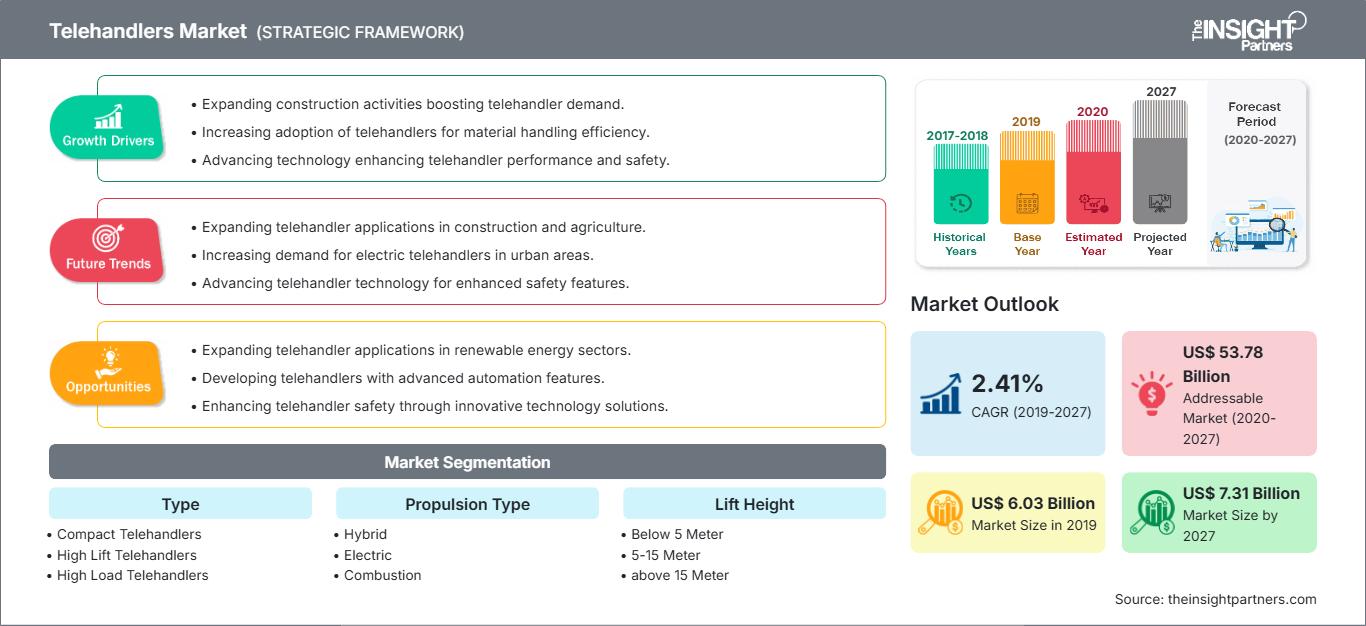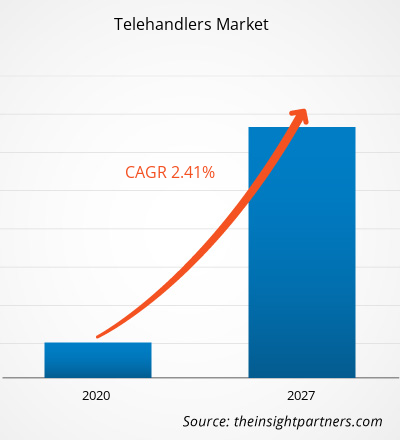[Rapporto di ricerca]Il mercato dei sollevatori telescopici è stato valutato a 6,03 miliardi di dollari nel 2019 e si prevede che crescerà a un CAGR del 2,41% dal 2020 al 2027, raggiungendo i 7,31 miliardi di dollari entro il 2027.
Il mercato dei sollevatori telescopici ha registrato una crescita eminente negli ultimi due anni a livello globale. Fattori come l'aumento dei progetti minerari, agricoli e infrastrutturali stanno trainando la domanda di attrezzature per l'edilizia, inclusi i sollevatori telescopici, in tutto il mondo. Inoltre, l'emergere di tecnologie intelligenti e l'introduzione di sollevatori telescopici elettrici. Oltre al settore edile, anche il settore agricolo svolge un ruolo essenziale nello stimolare la domanda di sollevatori telescopici sul mercato. Stati Uniti, Cina, India e Brasile sono tra i principali paesi dediti alle attività agricole. Il sollevatore telescopico è un'attrezzatura meccanica utilizzata in diversi settori come l'estrazione mineraria, la silvicoltura, l'edilizia e l'agricoltura. L'uso dei sollevatori telescopici è ampiamente osservato nei mercati nordamericani ed europei, mentre nel mercato asiatico non è ampiamente adottato. In Asia vengono utilizzate altre macchine alternative come le mini gru. Al contrario, la situazione economica dei paesi asiatici continua a crescere, il che potrebbe fornire ai fornitori di sollevatori telescopici una piattaforma per espandere il loro mercato in economie emergenti non sfruttate.
Approfondimenti di mercato: crescita del settore minerario e delle costruzioni
La crescita trainata dalle infrastrutture in paesi come la Cina ha portato a un'elevata crescita economica e a un aumento della domanda di materie prime come minerale di ferro, carbone, manganese, cobalto e rame. Le attività di esplorazione per i minerali e i metalli necessari sono vitali per la crescita complessiva dell'industria mineraria. Inoltre, la crescita dei progetti infrastrutturali e lo sviluppo dell'industria urbana stanno alimentando la domanda di attrezzature per l'edilizia nel settore. A causa dell'aumento dei progetti infrastrutturali a livello globale, cresce la necessità di attrezzature integrate con tecnologie sofisticate per garantire un livello di produttività più elevato.
A causa dei fattori sopra menzionati, si prevede una crescita del mercato dei sollevatori telescopici.
Personalizza questo rapporto in base alle tue esigenze
Potrai personalizzare gratuitamente qualsiasi rapporto, comprese parti di questo rapporto, o analisi a livello di paese, pacchetto dati Excel, oltre a usufruire di grandi offerte e sconti per start-up e università
Mercato dei sollevatori telescopici: Approfondimenti strategici

- Ottieni le principali tendenze chiave del mercato di questo rapporto.Questo campione GRATUITO includerà l'analisi dei dati, che vanno dalle tendenze di mercato alle stime e alle previsioni.
Impatto del Covid-19 sul mercato dei sollevatori telescopici:
Potrai personalizzare gratuitamente qualsiasi rapporto, comprese parti di questo rapporto, o analisi a livello di paese, pacchetto dati Excel, oltre a usufruire di grandi offerte e sconti per start-up e università
Mercato dei sollevatori telescopici: Approfondimenti strategici

- Ottieni le principali tendenze chiave del mercato di questo rapporto.Questo campione GRATUITO includerà l'analisi dei dati, che vanno dalle tendenze di mercato alle stime e alle previsioni.
La pandemia di COVID-19 (coronavirus) del 2019-20 ha avuto un impatto significativo sulla società, sulla salute pubblica e sull'economia nel suo complesso. Inoltre, ha causato caos in una miriade di settori come l'edilizia, la produzione manifatturiera e l'industria mineraria. Nel tentativo di fermare la diffusione del virus, diverse aziende stanno adottando misure per garantire la sicurezza e il benessere dei dipendenti. I progetti edilizi sono stati sospesi a causa dell'epidemia di Covid-19. Inoltre, le industrie manifatturiere hanno chiuso i loro stabilimenti a causa del lockdown. Ad esempio, JLG Industries ha sospeso la produzione negli Stati Uniti e in Francia, mentre in Cina e Romania gli stabilimenti sono operativi con una forza lavoro limitata. Arresti o produzioni a bassa capacità sono i principali fattori che potrebbero avere un impatto ulteriore sul settore degli utenti finali, come l'edilizia, per ulteriori attività e, in ultima analisi, sull'adozione dei sollevatori telescopici.
Approfondimenti sulla tipologia
In base alla tipologia, il mercato dei sollevatori telescopici è segmentato in sollevatori telescopici compatti, sollevatori telescopici ad alta portata e sollevatori telescopici ad alto carico. Il segmento dei sollevatori telescopici ad alta portata ha conquistato una quota dominante nel mercato globale dei sollevatori telescopici. La crescita delle attività edilizie e minerarie a livello globale richiede l'impiego di sollevatori telescopici ad alta portata per semplificare le operazioni complessive sollevando carichi pesanti a grandi altezze. Questi sollevatori telescopici vengono utilizzati anche nei settori dell'edilizia, della produzione, dell'immagazzinamento, dell'estrazione mineraria e delle cave.
Approfondimenti sulla tipologia di propulsione
Il mercato dei sollevatori telescopici, in base alla tipologia di propulsione, è segmentato in ibrido, a combustione ed elettrico. Il segmento a combustione ha conquistato una quota dominante nel mercato globale dei sollevatori telescopici. I sollevatori telescopici, che utilizzano motori a combustione interna, utilizzano una varietà di combustibili come benzina, gas di petrolio liquefatto (GPL), gasolio e gas naturale compresso.
Approfondimenti sulla capacità di sollevamento
In base alla capacità di sollevamento, il mercato dei sollevatori telescopici è segmentato in meno di 3 tonnellate, da 3 a 10 tonnellate e oltre 10 tonnellate. Il segmento da 3 a 10 tonnellate ha conquistato una quota dominante nel mercato globale dei sollevatori telescopici. I sollevatori telescopici sono ampiamente compatibili con un'ampia gamma di accessori grazie al sistema RFID che riconosce automaticamente la creazione di diagrammi di carico dinamici per soddisfare le numerose esigenze del settore manifatturiero e delle costruzioni.
Approfondimenti sull'altezza di sollevamento
Il mercato dei sollevatori telescopici, in base all'altezza di sollevamento, è segmentato in meno di 5 metri, da 5 a 15 metri e oltre 15 metri. Il segmento da 5 a 15 metri ha conquistato una quota dominante nel mercato globale dei sollevatori telescopici. I sollevatori telescopici con altezze comprese tra 5 e 15 metri sono progettati per offrire i massimi livelli di produttività e prestazioni, insieme a costi di gestione contenuti, versatilità invidiabile, qualità costruttiva di prim'ordine e un'ampia gamma di accessori.
Consigli per l'utente finale
Il mercato dei sollevatori telescopici, per utente finale, è segmentato in edilizia, agricoltura, estrazione mineraria, silvicoltura e altri settori. Il segmento dell'edilizia ha conquistato una quota dominante nel mercato globale dei sollevatori telescopici. Il crescente settore edile, con l'aumento dello sviluppo delle infrastrutture sanitarie, sociali ed educative a livello globale, richiede sollevatori telescopici per il sollevamento dei carichi.
Iniziative di mercato e nuove strategie di sviluppo sono comunemente adottate dalle aziende per espandere la propria presenza a livello mondiale e soddisfare la crescente domanda. Queste strategie si osservano principalmente in Nord America e in Europa. Gli operatori presenti nel mercato dei sollevatori telescopici adottano strategie di espansione e investimenti in ricerca e sviluppo per ampliare la base clienti in tutto il mondo, il che consente loro anche di mantenere il proprio marchio a livello globale.
Approfondimenti regionali sul mercato dei sollevatori telescopici
Le tendenze regionali e i fattori che influenzano il mercato dei sollevatori telescopici durante il periodo di previsione sono stati ampiamente spiegati dagli analisti di The Insight Partners. Questa sezione analizza anche i segmenti e la distribuzione geografica del mercato dei sollevatori telescopici in Nord America, Europa, Asia-Pacifico, Medio Oriente e Africa, America Meridionale e Centrale.
Ambito del rapporto di mercato sui sollevatori telescopici
| Attributo del rapporto | Dettagli |
|---|---|
| Dimensioni del mercato in 2019 | US$ 6.03 Billion |
| Dimensioni del mercato per 2027 | US$ 7.31 Billion |
| CAGR globale (2019 - 2027) | 2.41% |
| Dati storici | 2017-2018 |
| Periodo di previsione | 2020-2027 |
| Segmenti coperti |
By Tipo
|
| Regioni e paesi coperti | Nord America
|
| Leader di mercato e profili aziendali chiave |
|
Densità degli operatori del mercato dei sollevatori telescopici: comprendere il suo impatto sulle dinamiche aziendali
Il mercato dei sollevatori telescopici è in rapida crescita, trainato dalla crescente domanda degli utenti finali, dovuta a fattori quali l'evoluzione delle preferenze dei consumatori, i progressi tecnologici e una maggiore consapevolezza dei vantaggi del prodotto. Con l'aumento della domanda, le aziende stanno ampliando la propria offerta, innovando per soddisfare le esigenze dei consumatori e sfruttando le tendenze emergenti, alimentando ulteriormente la crescita del mercato.

- Ottieni il Mercato dei sollevatori telescopici Panoramica dei principali attori chiave
- Sollevatore telescopico compatto
- Sollevatore telescopico ad alto sollevamento
- Sollevatore telescopico ad alto carico
Mercato globale dei sollevatori telescopici: per tipo di propulsione
- Ibrido
- A combustione
- Elettrico
Mercato globale dei sollevatori telescopici: per altezza di sollevamento
- Inferiore a 5 metri
- Da 5 a 15 metri
- Oltre i 15 metri
Mercato globale dei sollevatori telescopici: per capacità di sollevamento
- Inferiore a 3 tonnellate
- Da 3 a 10 tonnellate
- Oltre le 10 tonnellate
Mercato globale dei sollevatori telescopici: Per tipo di attrezzatura
- Edilizia
- Agricoltura
- Estrazione mineraria
- Silvicoltura
- Altro
Mercato dei sollevatori telescopici - Per area geografica
Nord America
- Stati Uniti
- Canada
- Messico
Europa
- Francia
- Germania
- Italia
- Regno Unito
- Russia
- Resto d'Europa
Asia Pacifico
- Cina
- India
- Australia
- Corea del Sud
- Giappone
- Resto dell'Asia Pacifico
Medio Oriente e Africa
- Sudafrica
- Arabia Saudita
- Emirati Arabi Uniti
- Resto del Medio Oriente e Africa
Sudamerica
- Brasile
- Argentina
- Resto del Sud America
Profili aziendali
- AB Volvo
- Bobcat Company
- Caterpillar Inc.
- CNH Industrial NV
- Gruppo Hauloutte
- JLG Industries, Inc.
- Komatsu Ltd.
- Gruppo Liebherr
- Manitou BF
- Terex Corporation
- Analisi storica (2 anni), anno base, previsione (7 anni) con CAGR
- Analisi PEST e SWOT
- Valore/volume delle dimensioni del mercato - Globale, Regionale, Nazionale
- Industria e panorama competitivo
- Set di dati Excel
Report recenti
Testimonianze
Motivo dell'acquisto
- Processo decisionale informato
- Comprensione delle dinamiche di mercato
- Analisi competitiva
- Analisi dei clienti
- Previsioni di mercato
- Mitigazione del rischio
- Pianificazione strategica
- Giustificazione degli investimenti
- Identificazione dei mercati emergenti
- Miglioramento delle strategie di marketing
- Aumento dell'efficienza operativa
- Allineamento alle tendenze normative






















 Ottieni un campione gratuito per - Mercato dei sollevatori telescopici
Ottieni un campione gratuito per - Mercato dei sollevatori telescopici